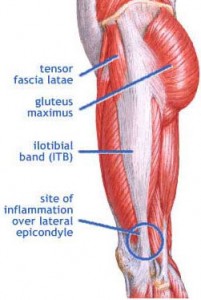So, a very common issue I see in runners is iliotibial band (ITB) syndrome. In a nutshell, it involves excessive rubbing or friction of the ITB along the greater trochanter or lateral femoral epicondyle. It is more common along the lower leg just above the knee and typically worsens with increasing mileage or stairs.

The ITB is essential for stabilizing the knee during running. Several factors may contribute to increased risk for this problem:
- Muscle imbalances (weak gluteus medius and deep hip external rotators)
- Uneven leg length
- High and low arches
- Increased pronation leading to excessive tibial rotation = friction of the band
- Improper training progression
- Faulty footwear
- Poor running mechanics
- Limited ankle mobility (specifically dorsiflexion)
- Tightness in the tensor fascia latae (TFL) and glute max
Related information on this topic include a 2010 study published in JOSPT on competitive female runners with ITB syndrome:
Click here to see the abstract of the study
Click here to read an earlier blog post analysis of the above research article
Common signs and symptoms include stinging or nagging lateral knee pain that worsens with continued running. Hills and stairs may further aggravate symptoms. Some runners even note a “locking up” sensation that forces them to stop running altogether. How do I treat this?
I advocate the following steps:
- PT evaluation with running specific joint assessments – this would include components of the SFMA or FMS based on the client and current situation
- Initiate and instruct in foam rolling
- Initiate and instruct in stretching to follow the foam rolling
- Begin corrective exercises to eliminate asymmetry
- Modify activity as needed based 100% on pain response
- Re-test and re-screen to gage effectiveness of corrective exercises
The foam rolling positions I like are pictured below as they hit the various angles of soft tissue as it courses along the band itself. Seeking the “hot spots” is a must. Moving up the hip to roll over the TFL is important even though the pain may be closer to the knee. Roll for 30-60 seconds at a time.



Note: Most runners I see develop this on one side only in response to asymmetry and imbalances. The LQYBT (lower quarter Y-Balance test) may prove useful in assessing limb asymmetry and hip stability for these clients. For more on the Y-Balance test simply click here.
As far as stretching goes, I find that it can be difficult to get a “good stretch.” The following two stretches are a few I teach clients to try at home. The table stretch is one I do with stabilization and overpressure, but some clients like doing it at home and letting gravity gently stretch the hip/ITB holding for 20-30 seconds and repeating 2-3 times.

Another stretch I like is the rope stretch. I often encourage a 2-3 second hold on this one and repeat 10 repetitions. However, sustained holds for 20-30 seconds are fine as well.

These are some quick and effective ways to attack soft tissue restriction and fascial tightness. Advanced users may want to use a softball or lacrosse ball to isolate the tissue and work even deeper. Graston is also effective for this condition. Keep in mind that stretches for the gluteus maximus such as a figure 4 stretch with hip flexion are also helpful since the glute max attaches directly to the ITB.
In addition to addressing soft tissue problems, be sure to identify kinetic chain factors such as weakness, stiffness or asymmetry that may be the underlying cause of the ITB syndrome to begin with. Often the source of the lateral knee pain originates above or below the knee joint.
In many cases strengthening the gluteus medius is a primary goal, while trying to reduce the natural TFL dominance that so many clients gravitate toward. I like side bridges and straight leg raises, but watch out for hip flexion as this is a sign of TFL dominance! I utilize the Redcord exercise below and the side plank progression with many of my clients to increase gluteus medius strength – very effective too.



Keeping the body straight with these exercises is a must in order to reprogram the body to engage the right muscles more consistently. My final piece of advice is to use ice for pain control and practice activity modification when inflammation and pain are limiting performance as running through this does not solve the problem.
If you need a good foam roller or complete soft tissue care running kit, be sure to check out the Trigger Point products on my site at www.brianschiff.com.

